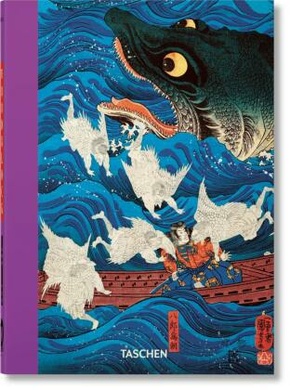| Verlag | Taschen Verlag |
| Auflage | 2021 |
| Seiten | 512 |
| Format | 16,3 x 4,2 x 22,7 cm |
| Gewicht | 1294 g |
| Reihe | 40th Edition |
| ISBN-10 | 3836587513 |
| ISBN-13 | 9783836587518 |
| Bestell-Nr | 83658751A |
Der japanische Holzschnitt ist ein Phänomen ohne westliches Pendant. Neben atemberaubenden Landschaften und erotischen Szenen stellt er Schrecken verbreitende Geister und Dämonen ebenso dar wie Sumo-Ringer, Kabuki-Schauspieler und Kurtisanen, die von ihren Fans wie Popstars gefeiert werden. Diese handliche Jubiläumsausgabe präsentiert die außergewöhnlichsten Meisterwerke von 1680 bis 1938, deren beste Drucke aus Museen und Sammlungen weltweit zusammengetragen wurden.
Von Edouard Manets Porträt des Schriftstellers Émile Zola, der inmitten seiner japanischen Kunstfunde hockt, bis hin zu Van Goghs akribisch gesammelten Hiroshige-Drucken - Pioniere der europäischen Moderne machten im 19. Jahrhundert kein Geheimnis aus ihrer Liebe zur japanischen Kunst. In all seiner sprudelnden Sinnlichkeit und Freizügigkeit schreibt man den Trend des Japonismus allein dem Holzschnitt zu, der zunächst Frankreich und später ganz Europa in seinen Bann zog - oft missverstandene, "exotische" Artefakte, die der westlichen Kreativität als Inspiration dienten.
Tatsache ist, dass der japanische Holzschnitt ein Phänomen darstellt, zu dem es kein westliches Äquivalent gibt. Einige wegweisende Ideen der Moderne - darunter Karl Marx' Diktum, dass "alles, was fest ist, sich in der Luft auflöst" - wurden im Japan des 17. Jahrhunderts entwickelt und im frühen 19. Jahrhundert erstmals in den Werken von Meistern wie Hokusai, Utamaro und Hiroshige zum Ausdruck gebracht.< br>
Dieses Buch, basierend auf der ursprünglichen XXL-Monografie, lüftet den Schleier dieser beliebten, aber wenig verstandenen Kunstform und präsentiert die außergewöhnlichsten japanischen Holzschnitte in ihrem historischen Kontext. Die hier versammelten Werke reichen von den Anfängen über den Höhepunkt der Entwicklung im Ukiyo-e, den "Bildern der schwebenden Welt", im 17. Jahrhundert bis zum Niedergang und späteren Wiederaufleben der Drucke im frühen 20. Jahrhundert. Dokumentiert wird nicht nur ein einzigartiges Genre der Kunstgeschichte, sondern auch die sich wandelnden Sitten und die kulturelle Entwicklung Japans.
Von mystischen Bergen bis hin zu schneebedeckten Pässen, von Samurai-Schwertkämpfern bis hin zu Sexarbeitern in Schaufenstern - dieser Band erkundet jedes Blatt als eigenständiges Kunstwerk und enthüllt die Geschichten und Menschen hinter den Motiven. Wir entdecken die vier Säulen des Holzschnitts - Schönheiten, Schauspieler, Landschaften sowie Vogel- und B lumenkompositionen - neben Darstellungen von Sumo-Ringern, Kabuki-Schauspielern oder Edelkurtisanen - Popstars, welche die "schwebende Welt" bevölkerten und deren wachsende Anhängerschaft die explosive Produktion der Holzschnitte beflügelte. Wir tauchen ein in bedrohlich-obskure Szenen, in denen Dämonen, Geister und Menschenfresser Angst und Schrecken verbreiten und die japanische Mangas, Filme und Videospiele bis heute beeinflussen. Wir erleben, wie technische Meisterschaft und das unfehlbare Auge ihrer Schöpfer diese Werke in ihrer unglaublichen Breite - von Alltagsszenen über Erotik, Kampfkunst bis hin zur Mythologie - vereint und wie Verleger und Künstler mit enormem Einfallsreichtum und Augenzwinkern gleichermaßen darum gekämpft haben, die staatliche Zensur zu umgehen.
Diese Ausgabe stellt die besten erhaltenen Drucke aus Museen und Privatsammlungen weltweit in einem handlichen Format zusammen und bietet ausführliche Beschreibungen, die uns durch diese rasante Periode der japanischen Kunstgeschichte führen.

